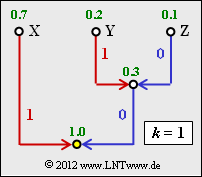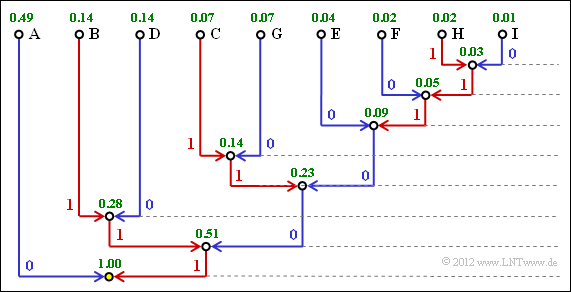Difference between revisions of "Aufgaben:Exercise 2.7Z: Huffman Coding for Two-Tuples of a Ternary Source"
From LNTwww
m (Text replacement - "Category:Aufgaben zu Informationstheorie" to "Category:Information Theory: Exercises") |
|||
| (16 intermediate revisions by 2 users not shown) | |||
| Line 1: | Line 1: | ||
| − | {{quiz-Header|Buchseite= | + | {{quiz-Header|Buchseite=Information_Theory/Entropy_Coding_According_to_Huffman |
}} | }} | ||
| − | [[File:P_ID2458__Inf_Z_2_7.png|right|frame| | + | [[File:P_ID2458__Inf_Z_2_7.png|right|frame|Huffman tree for <br>a ternary source]] |
| − | + | We consider the same situation as in [[Aufgaben:Exercise_2.7:_Huffman_Application_for_Binary_Two-Tuples|Exercise A2.7]]: | |
| − | * | + | *The Huffman algorithm leads to a better result, i.e. to a smaller average code word length $L_{\rm M}$, if one does not apply it to individual symbols but forms $k$–tuples beforehand. |
| − | * | + | *This increases the symbol set size from $M$ to $M\hspace{0.03cm}' = M^k$. |
| − | + | For the message source considered here, the following applies: | |
| − | * | + | * Symbol set size: $M = 3$, |
| − | * | + | * Symbol set: $\{$ $\rm X$, $\rm Y$, $\rm Z$ $\}$, |
| − | * | + | * Probabilities: $p_{\rm X} = 0.7$, $p_{\rm Y} = 0.2$, $p_{\rm Z} = 0.1$, |
| − | * | + | * Entropy: $H = 1.157 \ \rm bit/ternary\hspace{0.12cm}symbol$. |
| − | + | The graph shows the Huffman tree when the Huffman algorithm is applied to single symbols $(k= 1)$. <br>In subtask '''(2)''' you are to give the corresponding Huffman code when two-tuples are formed beforehand $(k=2)$. | |
| − | + | <u>Hints:</u> | |
| − | + | *The exercise belongs to the chapter [[Information_Theory/Entropiecodierung_nach_Huffman|Entropy Coding according to Huffman]]. | |
| − | + | *In particular, reference is made to the page [[Information_Theory/Entropiecodierung_nach_Huffman#Application_of_Huffman_coding_to_.7F.27.22.60UNIQ-MathJax168-QINU.60.22.27.7F.E2.80.93tuples|Application of Huffman coding to $k$-tuples]]. | |
| − | + | *A comparable task with binary input symbols is dealt with in [[Aufgaben:Exercise_2.7:_Huffman_Application_for_Binary_Two-Tuples|Exercise 2.7]] . | |
| − | + | *Designate the possible two-tuples with $\rm XX = A$, $\rm XY = B$, $\rm XZ = C$, $\rm YX = D$, $\rm YY = E$, $\rm YZ = F$, $\rm ZX = G$, $\rm ZY = H$, $\rm ZZ = I$. | |
| − | * | ||
| − | * | ||
| − | * | ||
| − | * | ||
| − | === | + | ===Questions=== |
<quiz display=simple> | <quiz display=simple> | ||
| − | { | + | {What is the average code word length when the Huffman algorithm is applied directly to the ternary source symbols $\rm X$, $\rm Y$ und $\rm Z$ ? |
|type="{}"} | |type="{}"} | ||
| − | $\underline{k=1}\text{:} \hspace{0.25cm}L_{\rm M} \ = \ $ { 1.3 3% } $\ \rm bit/ | + | $\underline{k=1}\text{:} \hspace{0.25cm}L_{\rm M} \ = \ $ { 1.3 3% } $\ \rm bit/source\hspace{0.12cm}symbol$ |
| − | { | + | {What are the tuple probabilities here? In particular: |
|type="{}"} | |type="{}"} | ||
$p_{\rm A} = \rm Pr(XX)\ = \ $ { 0.49 3% } | $p_{\rm A} = \rm Pr(XX)\ = \ $ { 0.49 3% } | ||
| Line 48: | Line 44: | ||
| − | { | + | {What is the average code word length if you first form two-tuples and apply the Huffman algorithm to them? |
|type="{}"} | |type="{}"} | ||
| − | $\underline{k=2}\text{:} \hspace{0.25cm}L_{\rm M} \ = \ $ { 1.165 3% } $\ \rm bit/ | + | $\underline{k=2}\text{:} \hspace{0.25cm}L_{\rm M} \ = \ $ { 1.165 3% } $\ \rm bit/source\hspace{0.12cm}symbol$ |
| − | { | + | {Which of the following statements are true when more than two ternary symbols are combined $(k>2)$? |
|type="[]"} | |type="[]"} | ||
| − | + $L_{\rm M}$ | + | + $L_{\rm M}$ decreases monotonically with increasing $k$. |
| − | - $L_{\rm M}$ | + | - $L_{\rm M}$ does not change when $k$ is increased. |
| − | - Für $k= 3$ | + | - Für $k= 3$ you get $L_{\rm M} = 1.05 \ \rm bit/source\hspace{0.12cm}symbol$. |
| Line 63: | Line 59: | ||
</quiz> | </quiz> | ||
| − | === | + | ===Solution=== |
{{ML-Kopf}} | {{ML-Kopf}} | ||
| − | '''(1)''' | + | '''(1)''' The average code word length is with $p_{\rm X} = 0.7$, $L_{\rm X} = 1$, $p_{\rm Y} = 0.2$, $L_{\rm Y} = 2$, $p_{\rm Z} = 0.1$, $L_{\rm Z} = 2$: |
| − | :$$L_{\rm M} = p_{\rm X} \cdot 1 + (p_{\rm Y} + p_{\rm Z}) \cdot 2 \hspace{0.15cm}\underline{= 1.3\,\,{\rm bit/ | + | :$$L_{\rm M} = p_{\rm X} \cdot 1 + (p_{\rm Y} + p_{\rm Z}) \cdot 2 \hspace{0.15cm}\underline{= 1.3\,\,{\rm bit/source\:symbol}}\hspace{0.05cm}. $$ |
| − | * | + | *This value is greater than the source entropy $H = 1.157$ bit/source symbol. |
| − | '''(2)''' | + | '''(2)''' There are $M\hspace{0.03cm}' = M^k = 3^2 = 9$ two-tuples with the following probabilities: |
| − | [[File:P_ID2459__Inf_Z_2_7c.png|right|frame| | + | [[File:P_ID2459__Inf_Z_2_7c.png|right|frame|Huffman tree for ternary source and two-tuples.]] |
:$$p_{\rm A} = \rm Pr(XX) = 0.7 \cdot 0.7\hspace{0.15cm}\underline{= 0.49},$$ | :$$p_{\rm A} = \rm Pr(XX) = 0.7 \cdot 0.7\hspace{0.15cm}\underline{= 0.49},$$ | ||
:$$p_{\rm B} = \rm Pr(XY) = 0.7 \cdot 0.2\hspace{0.15cm}\underline{= 0.14},$$ | :$$p_{\rm B} = \rm Pr(XY) = 0.7 \cdot 0.2\hspace{0.15cm}\underline{= 0.14},$$ | ||
| Line 85: | Line 81: | ||
<br clear=all> | <br clear=all> | ||
| − | '''(3)''' | + | '''(3)''' The graph shows the Huffman tree for the application with $k = 2$. Thus we obtain |
| − | * | + | * for the individual two-tuples the following binary codings: <br> |
: $\rm XX = A$ → '''0''', $\rm XY = B$ → '''111''', $\rm XZ = C$ → <b>1011</b>, | : $\rm XX = A$ → '''0''', $\rm XY = B$ → '''111''', $\rm XZ = C$ → <b>1011</b>, | ||
: $\rm YX = D$ → <b>110</b>, $\rm YY = E$ → <b>1000</b>, $\rm YZ = F$ → <b>10010</b>, | : $\rm YX = D$ → <b>110</b>, $\rm YY = E$ → <b>1000</b>, $\rm YZ = F$ → <b>10010</b>, | ||
: $\rm ZX = G$ → <b>1010</b>, $\rm ZY = H$ → <b>100111</b>, $\rm ZZ =I$ → <b>100110</b>; | : $\rm ZX = G$ → <b>1010</b>, $\rm ZY = H$ → <b>100111</b>, $\rm ZZ =I$ → <b>100110</b>; | ||
| − | * | + | * for the average code word length: |
| − | :$$L_{\rm M}\hspace{0.01cm}' =0.49 \cdot 1 + (0.14 + 0.14) \cdot 3 + (0.07 + 0.04 + 0.07) \cdot 4 + 0.02 \cdot 5 + (0.02 + 0.01) \cdot 6 = 2.33\,\,{\rm bit/ | + | :$$L_{\rm M}\hspace{0.01cm}' =0.49 \cdot 1 + (0.14 + 0.14) \cdot 3 + (0.07 + 0.04 + 0.07) \cdot 4 + 0.02 \cdot 5 + (0.02 + 0.01) \cdot 6 = 2.33\,\,{\rm bit/two tuples}$$ |
| − | :$$\Rightarrow\hspace{0.3cm}L_{\rm M} = {L_{\rm M}\hspace{0.01cm}'}/{2}\hspace{0.15cm}\underline{ = 1.165\,\,{\rm bit/ | + | :$$\Rightarrow\hspace{0.3cm}L_{\rm M} = {L_{\rm M}\hspace{0.01cm}'}/{2}\hspace{0.15cm}\underline{ = 1.165\,\,{\rm bit/source\hspace{0.12cm}symbol}}\hspace{0.05cm}.$$ |
| − | '''(4)''' | + | '''(4)''' <u>Statement 1</u> is correct, even if $L_{\rm M}$ decreases very slowly as $k$ increases. |
| − | * | + | * The last statement is false because $L_{\rm M}$ cannot be smaller than $H = 1.157$ bit/source symbol even for $k → ∞$ . |
| − | + | * But the second statement is not necessarily correct either: Since $L_{\rm M} > H$ still applies with $k = 2$ , $k = 3$ can lead to a further improvement. | |
{{ML-Fuß}} | {{ML-Fuß}} | ||
| − | [[Category:Information Theory: Exercises|^2.3 | + | [[Category:Information Theory: Exercises|^2.3 Entropy Coding according to Huffman^]] |
Latest revision as of 16:57, 1 November 2022
We consider the same situation as in Exercise A2.7:
- The Huffman algorithm leads to a better result, i.e. to a smaller average code word length $L_{\rm M}$, if one does not apply it to individual symbols but forms $k$–tuples beforehand.
- This increases the symbol set size from $M$ to $M\hspace{0.03cm}' = M^k$.
For the message source considered here, the following applies:
- Symbol set size: $M = 3$,
- Symbol set: $\{$ $\rm X$, $\rm Y$, $\rm Z$ $\}$,
- Probabilities: $p_{\rm X} = 0.7$, $p_{\rm Y} = 0.2$, $p_{\rm Z} = 0.1$,
- Entropy: $H = 1.157 \ \rm bit/ternary\hspace{0.12cm}symbol$.
The graph shows the Huffman tree when the Huffman algorithm is applied to single symbols $(k= 1)$.
In subtask (2) you are to give the corresponding Huffman code when two-tuples are formed beforehand $(k=2)$.
Hints:
- The exercise belongs to the chapter Entropy Coding according to Huffman.
- In particular, reference is made to the page Application of Huffman coding to $k$-tuples.
- A comparable task with binary input symbols is dealt with in Exercise 2.7 .
- Designate the possible two-tuples with $\rm XX = A$, $\rm XY = B$, $\rm XZ = C$, $\rm YX = D$, $\rm YY = E$, $\rm YZ = F$, $\rm ZX = G$, $\rm ZY = H$, $\rm ZZ = I$.
Questions
Solution
(1) The average code word length is with $p_{\rm X} = 0.7$, $L_{\rm X} = 1$, $p_{\rm Y} = 0.2$, $L_{\rm Y} = 2$, $p_{\rm Z} = 0.1$, $L_{\rm Z} = 2$:
- $$L_{\rm M} = p_{\rm X} \cdot 1 + (p_{\rm Y} + p_{\rm Z}) \cdot 2 \hspace{0.15cm}\underline{= 1.3\,\,{\rm bit/source\:symbol}}\hspace{0.05cm}. $$
- This value is greater than the source entropy $H = 1.157$ bit/source symbol.
(2) There are $M\hspace{0.03cm}' = M^k = 3^2 = 9$ two-tuples with the following probabilities:
- $$p_{\rm A} = \rm Pr(XX) = 0.7 \cdot 0.7\hspace{0.15cm}\underline{= 0.49},$$
- $$p_{\rm B} = \rm Pr(XY) = 0.7 \cdot 0.2\hspace{0.15cm}\underline{= 0.14},$$
- $$p_{\rm C} = \rm Pr(XZ) = 0.7 \cdot 0.1\hspace{0.15cm}\underline{= 0.07},$$
- $$p_{\rm D} = \rm Pr(YX) = 0.2 \cdot 0.7 = 0.14,$$
- $$p_{\rm E} = \rm Pr(YY) = 0.2 \cdot 0.2 = 0.04,$$
- $$p_{\rm F} = \rm Pr(YZ) = 0.2 \cdot 0.1 = 0.02,$$
- $$p_{\rm G} = \rm Pr(ZX) = 0.1 \cdot 0.7 = 0.07,$$
- $$p_{\rm H} = \rm Pr(ZY) = 0.1 \cdot 0.2 = 0.02,$$
- $$p_{\rm I} = \rm Pr(ZZ) = 0.1 \cdot 0.1 = 0.01.$$
(3) The graph shows the Huffman tree for the application with $k = 2$. Thus we obtain
- for the individual two-tuples the following binary codings:
- $\rm XX = A$ → 0, $\rm XY = B$ → 111, $\rm XZ = C$ → 1011,
- $\rm YX = D$ → 110, $\rm YY = E$ → 1000, $\rm YZ = F$ → 10010,
- $\rm ZX = G$ → 1010, $\rm ZY = H$ → 100111, $\rm ZZ =I$ → 100110;
- for the average code word length:
- $$L_{\rm M}\hspace{0.01cm}' =0.49 \cdot 1 + (0.14 + 0.14) \cdot 3 + (0.07 + 0.04 + 0.07) \cdot 4 + 0.02 \cdot 5 + (0.02 + 0.01) \cdot 6 = 2.33\,\,{\rm bit/two tuples}$$
- $$\Rightarrow\hspace{0.3cm}L_{\rm M} = {L_{\rm M}\hspace{0.01cm}'}/{2}\hspace{0.15cm}\underline{ = 1.165\,\,{\rm bit/source\hspace{0.12cm}symbol}}\hspace{0.05cm}.$$
(4) Statement 1 is correct, even if $L_{\rm M}$ decreases very slowly as $k$ increases.
- The last statement is false because $L_{\rm M}$ cannot be smaller than $H = 1.157$ bit/source symbol even for $k → ∞$ .
- But the second statement is not necessarily correct either: Since $L_{\rm M} > H$ still applies with $k = 2$ , $k = 3$ can lead to a further improvement.

